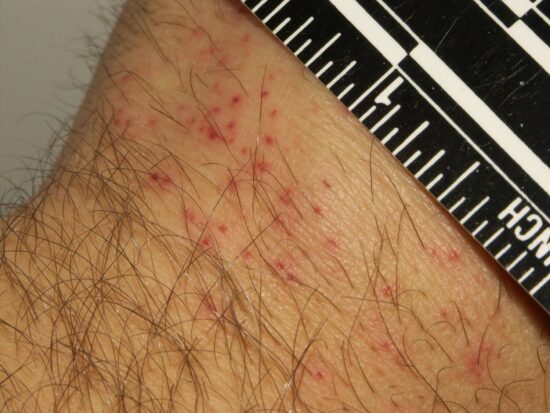Waking up with itchy, red bumps on your skin can be really frustrating, especially when you suspect bed bugs but can’t find any evidence of them. This situation happens more often than you might think. Many people experience what looks like bed bug bites but no sign of bed bugs anywhere in their home.
The good news is that there are logical steps you can take to figure out what’s really going on. Whether you’re dealing with actual bed bugs that are just really good at hiding, other types of insects, or even skin conditions that look like bug bites, this guide will help you get to the bottom of it.
1. Perform a Thorough Self-Inspection of Your Sleeping Area
The first step when you notice possible bed bug bites but no sign of bed bugs is to do a careful inspection of your bed and sleeping area. Bed bugs are masters at hiding, so you need to look closely and methodically.
Start by stripping all the bedding from your bed. Grab a bright flashlight and examine every inch of your mattress. Pay special attention to the seams, piping, and tags where bed bugs love to hide. Look for rusty or reddish stains on your sheets, which could be crushed bed bugs. Also watch for dark spots about the size of a period, which are bed bug droppings.
- Kill bed bugs and bed bug eggs
- Use spray as a spot treatment around bed frames, mattress seams/tufts/folds, and baseboards
- Kills even the toughest bed bugs
- The continuous spray Comfort Wand easily gets into hard-to-reach areas
Check for tiny pale yellow eggs or eggshells, which are about 1mm in size. Sometimes you might even spot live bugs, though they’re experts at staying hidden during the day. Don’t forget to check your box spring, bed frame, and headboard. Use a credit card or thin piece of plastic to probe into cracks and crevices.
If there’s a heavy infestation, you might notice a sweet, musty smell. However, many people experiencing bed bug bites but no sign of bed bugs might not detect this odor because the infestation could be small or just starting.
2. Expand Your Search Beyond the Bedroom
When getting bitten at night with no sign of bed bugs in your immediate sleeping area, it’s time to widen your search. Bed bugs can hide in many places throughout your home, not just in your bed.
Check the baseboards around your room, especially near your bed. Look at electrical outlets and light switches, and examine any cracks in the walls. Bed bugs can squeeze into spaces as thin as a credit card, so they can hide almost anywhere.
Remove the plates from electrical outlets and switches to inspect behind them. This might seem extreme, but bed bugs often hide in these dark spaces. Also check any framed pictures or artwork hanging on your walls. If you find evidence of bed bugs nearby, open the frames to inspect inside.
Don’t forget about upholstered furniture in other rooms. Chairs, sofas, and even curtains can harbor bed bugs if an infestation has spread. Fold back the edges of wall-to-wall carpets to check underneath, and inspect drawer joints and the undersides of furniture.
3. Rule Out Other Biting Insects
Sometimes what looks like bed bug bites but no sign of bed bugs is actually caused by other insects. Several common household pests can leave bite marks that are easily confused with bed bug bites.
Fleas are probably the most common culprit. Flea bites typically show up around your ankles and lower legs, and they’re often associated with pets. Unlike bed bugs, fleas are fast-moving and jump when disturbed, though they’re small enough that you might not notice them right away.
Mosquitoes can also cause confusion, especially if you have a window with a damaged screen. Mosquito bites usually appear as isolated bumps rather than the clusters or lines typical of bed bugs. They also tend to appear on any exposed skin, not just areas that touch your bed.
Spider bites are another possibility, though they’re less common. Most spider bites appear as single bumps, sometimes with two small puncture marks. Spiders generally only bite when they feel threatened.
Carpet beetles don’t actually bite, but their larvae have tiny hairs that can irritate your skin and cause welts that look like insect bites. These beetles can be found throughout your home, not just in carpeted areas.
4. Consider Non-Insect Skin Conditions
When you’re getting bitten at night with no sign of bed bugs, the cause might not be insects at all. Several skin conditions can create bumps and welts that look very similar to bug bites.
Heat rash, also called miliaria, is common in hot and humid conditions. It happens when your sweat ducts get blocked, creating small, itchy bumps that can be red, white, or clear. This condition is more likely if your bedroom gets very warm or if you’ve been sleeping under heavy blankets.
Contact dermatitis is an allergic reaction that happens when your skin touches something that irritates it. This could be a new laundry detergent, fabric softener, soap, or even new sheets or pillowcases. The reaction can take hours or even days to appear, which is why it’s often mistaken for insect bites.
Hives, also called urticaria, can appear as raised, itchy bumps that look very similar to bed bug bites. Hives can be triggered by stress, certain foods, medications, or even temperature changes. They often appear and disappear quickly, sometimes moving to different parts of your body.
Dermatitis herpetiformis is a rare autoimmune condition linked to gluten sensitivity. It causes itchy blisters and bumps, usually on the elbows, knees, back, or scalp. While uncommon, it’s worth considering if other causes have been ruled out.
- Kill bed bugs and bed bug eggs
- Use spray as a spot treatment around bed frames, mattress seams/tufts/folds, and baseboards
- Kills even the toughest bed bugs
- The continuous spray Comfort Wand easily gets into hard-to-reach areas
5. Examine Environmental Factors
Your living environment might be contributing to what seems like bed bug bites but no sign of bed bugs. Several environmental factors can cause skin irritation that mimics insect bites.
Check your windows for damaged screens. Even a small hole can let mosquitoes into your bedroom, especially if there’s an overhang or sheltered area just outside where mosquitoes might rest during the day. On warmer days, these mosquitoes can become active and fly through the opening.
Seasonal changes can also affect your skin. When the weather gets colder and heating systems turn on, indoor humidity drops dramatically. This can cause dry skin that becomes itchy and irritated, especially while sleeping under warm blankets.
Think about any recent changes in your home. Have you had new carpet installed, or has there been work done on your heating and cooling system? These activities can sometimes disturb insects or introduce irritants into your environment.
New products can also be the culprit. Recent changes in laundry detergent, soap, lotion, or even new medications can cause allergic reactions that show up as itchy bumps on your skin.
6. Document Your Symptoms and Patterns
When dealing with bed bug bites but no sign of bed bugs, keeping detailed records can help you identify the real cause. Take photos of the bumps or welts, noting their size, pattern, and location on your body.
Pay attention to when the bites appear. Bed bug bites often show up in clusters or lines, commonly called the “breakfast, lunch, and dinner” pattern. They typically appear on exposed skin like your arms, legs, neck, and face. The timing can also be important since bed bug bite reactions can take anywhere from a few hours to two weeks to appear.
Note whether other people in your home are experiencing similar symptoms. If only one person is getting bitten, it might point to an allergic reaction or sensitivity that others don’t have. If multiple people are affected, it’s more likely to be an environmental cause or actual insects.
Keep track of any activities or changes that coincide with the appearance of symptoms. This information can be very helpful when talking to a doctor or pest control professional.
7. Use Detection Tools and Traps
If you’re still experiencing what seems like bed bug bites but no sign of bed bugs, consider using detection tools to monitor for bed bug activity. These tools can help catch bed bugs if they’re present but just very good at hiding.
Bed bug interceptors are small traps that you place under the legs of your bed and other furniture. These devices catch bed bugs as they try to climb up to reach you while you sleep. They’re inexpensive and can be very effective at detecting low-level infestations.
You can also use passive detection devices near areas where you suspect bed bugs might be hiding. These don’t attract bed bugs but simply catch them if they happen to walk by.
Some pest control companies now use rapid test kits that can detect bed bug proteins with over 90% accuracy. While these are typically used by professionals, some are available for consumer use.
Remember that bed bugs can go several weeks between feedings, so you might need to monitor for quite a while to catch them if they’re present.
8. Consult a Medical Professional
When you’re getting bitten at night with no sign of bed bugs and home investigation hasn’t provided answers, it’s time to consult a medical professional. A doctor or dermatologist can help determine whether your symptoms are actually caused by insect bites or by a skin condition.
Doctors can rule out conditions like hives, fungal infections, or allergic reactions that might be causing your symptoms. Dermatologists are especially skilled at distinguishing between different types of skin conditions and can often identify the cause just by looking at the pattern and appearance of the bumps.
- Kill bed bugs and bed bug eggs
- Use spray as a spot treatment around bed frames, mattress seams/tufts/folds, and baseboards
- Kills even the toughest bed bugs
- The continuous spray Comfort Wand easily gets into hard-to-reach areas
Seek medical attention immediately if you experience severe symptoms like difficulty breathing, swelling of your face or throat, or extensive hives. These could be signs of a serious allergic reaction that needs prompt treatment.
Also get medical care if your bumps become infected. Signs of infection include increased redness, warmth, swelling, or discharge from the bite sites. Persistent itching that interferes with sleep or daily activities is another good reason to see a healthcare provider.
9. Call Professional Pest Control for Expert Inspection
If you’re still dealing with bed bug bites but no sign of bed bugs after your own investigation, it’s time to call in the professionals. Pest control experts have specialized training and tools that can detect infestations that homeowners might miss.
Professional inspectors use high-intensity flashlights, magnifying glasses, and specialized probes to examine areas that are difficult for homeowners to access. They also have experience knowing exactly where to look and what signs to watch for.
Some pest control companies use specially trained dogs for bed bug detection. These dogs have an incredible sense of smell and can detect bed bugs even when they’re hiding deep inside walls or furniture. A trained bed bug dog can inspect a room in just a few minutes with remarkable accuracy.
Even if the professional inspection doesn’t find bed bugs, the pest control expert might identify other insects that could be causing your problem. They can also provide advice on preventing future infestations and making your home less attractive to various pests.
10. Treat Current Symptoms and Prevent Secondary Infections
While you’re investigating the cause of your bed bug bites but no sign of bed bugs, it’s important to treat your current symptoms and prevent them from getting worse.
Wash all bite areas gently with soap and water. This helps prevent infection and can reduce itching. Apply over-the-counter corticosteroid cream to the affected areas to reduce inflammation and itching. You can also try Aveeno cream or other soothing lotions.
Take antihistamines if you’re experiencing allergic reactions. These can help reduce swelling and itching. Cold compresses can provide immediate relief from itching and swelling, and oatmeal baths are also very soothing for irritated skin.
The most important thing is to avoid scratching the affected areas. Scratching can lead to secondary infections and can make the symptoms much worse. Keep your fingernails short and consider wearing gloves at night if you tend to scratch in your sleep.
If your symptoms persist or worsen despite treatment, or if you notice signs of infection, contact a healthcare provider for further evaluation and treatment.
11. Implement Preventive Measures for Future Protection
Even if you never find the exact cause of your bed bug bites but no sign of bed bugs, you can take steps to prevent similar problems in the future.
When you travel, always inspect hotel rooms before settling in. Check the mattress, headboard, and nearby furniture for signs of bed bugs. Keep your luggage in the bathroom while you inspect, as bed bugs are less likely to be found in bathrooms.
When you return home from travel, put all clothing and other heat-tolerant items in the dryer on high heat for at least 20 minutes before washing them. The heat will kill any bed bugs or other insects that might have hitchhiked home with you.
Be cautious when guests visit after staying in hotels or other accommodations. After they leave, inspect guest rooms carefully for any signs of new pest activity.
Consider encasing your mattress and box springs in protective covers designed to prevent bed bugs. These covers can also help with dust mite allergies and keep your bedding cleaner overall.
Repair any damaged window screens to prevent mosquitoes and other flying insects from entering your home. Regular cleaning and reducing clutter can also eliminate hiding spots for various pests.
Finally, maintain good communication with family members or roommates about any bite symptoms so you can quickly identify and address pest problems before they become major infestations.
Conclusion
Dealing with what appears to be bed bug bites but no sign of bed bugs can be incredibly frustrating, but following these systematic steps will help you identify the true cause. Remember that many different factors can cause skin irritation that looks like insect bites, from other types of bugs to environmental factors to skin conditions.
The key is to be thorough in your investigation and don’t hesitate to seek professional help when needed. Whether the cause turns out to be actual bed bugs that are just very good at hiding, other insects, or a non-pest related issue, most problems are solvable once you identify what’s really going on.
Stay patient and methodical in your approach, and you’ll eventually get to the bottom of your mystery bites. With proper identification and treatment, you can get back to sleeping peacefully without worrying about what might be causing those annoying bumps on your skin.



